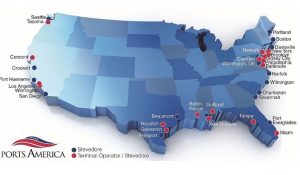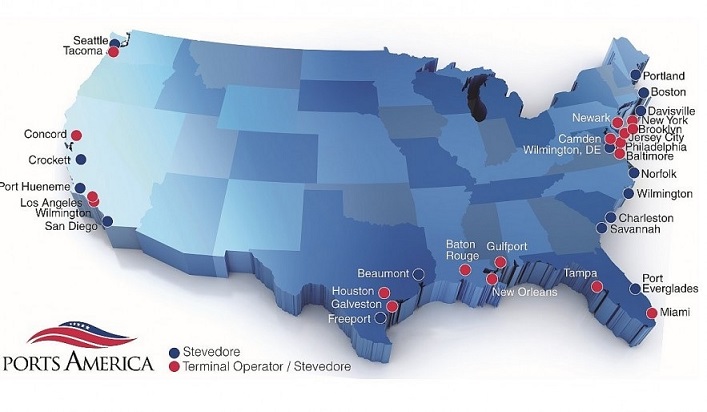Ports play a pivotal role in global trade, facilitating the movement of goods and connecting economies. However, they are also significant sources of pollution, contributing to greenhouse gas (GHG) emissions, air quality degradation, and environmental damage. In recent years, the United States has made significant strides toward mitigating the environmental impact of port operations by introducing green innovations and decarbonization initiatives. As the shipping industry seeks to align with global climate goals, U.S. ports have become critical arenas for cutting-edge technologies and strategies aimed at reducing carbon footprints.
This article explores the various green and decarbonization innovations currently being implemented in U.S. ports, the challenges faced, and the transformative potential these initiatives hold for the future of maritime logistics.

The Environmental Challenge: Ports as Major Polluters
Ports are bustling hubs of activity, involving the use of large vessels, cargo handling equipment, trucks, and rail systems. These activities release significant amounts of CO₂, nitrogen oxides (NOx), sulfur oxides (SOx), and particulate matter (PM) into the atmosphere. According to the Environmental Protection Agency (EPA), port-related activities contribute up to 10% of global transportation-related CO₂ emissions and are a primary source of air pollution in many coastal cities.
Given the urgency of climate change, the pressure to reduce the environmental footprint of port operations has grown. This has led to the adoption of green technologies, cleaner fuels, and sustainable practices at major U.S. ports.
Key Green and Decarbonization Innovations in U.S. Ports
1. Electrification of Port Equipment
One of the most promising solutions to decarbonize ports is the electrification of cargo handling equipment, which includes cranes, trucks, and forklifts. Many U.S. ports are transitioning from diesel-powered equipment to electric alternatives, which significantly reduce harmful emissions.
- Port of Los Angeles: The Port of Los Angeles, one of the largest in the U.S., has invested heavily in electrification. It has implemented an “all-electric” strategy, where electric trucks, cranes, and other handling equipment are replacing diesel-powered machines. The port has set a goal to become a zero-emissions facility by 2030.
- Port of Long Beach: Long Beach has made substantial investments in electrification, including the development of the first zero-emissions container terminal in the U.S., the Middle Harbor Redevelopment Project. This project has incorporated electric cargo handling equipment and charging infrastructure for electric trucks.
2. Shore Power for Ships
Shore power, also known as “cold ironing,” allows ships to plug into the local electrical grid while docked, rather than relying on auxiliary diesel engines to generate electricity. This reduces both GHG emissions and air pollution in surrounding communities.
- California Ports: Ports along the California coast, including Oakland, Long Beach, and Los Angeles, have implemented shore power programs. By 2023, ships at these ports are required to use shore power for at least 80% of their total time at dock. This has led to significant reductions in NOx and CO₂ emissions.
- Port of Seattle: The Port of Seattle is a leader in shore power, becoming the first U.S. port to provide shore power connections for cruise ships. Since 2009, shore power use at the Port of Seattle has reduced emissions equivalent to taking over 20,000 cars off the road annually.
3. Clean Fuels and Alternative Energy Sources
The shipping industry is also exploring alternative fuels and clean energy sources to power vessels and port equipment. These include liquefied natural gas (LNG), hydrogen, biofuels, and renewable energy sources like solar and wind.
- LNG-Powered Ships: LNG is being increasingly adopted as a cleaner alternative to diesel fuel. Ports such as Jacksonville, Florida, and Savannah, Georgia, are investing in LNG infrastructure to support the fueling of LNG-powered vessels. LNG reduces sulfur oxides and particulate matter emissions, offering an immediate reduction in the environmental footprint.
- Hydrogen Fuel Cells: Hydrogen is emerging as a key player in the decarbonization of port operations. The Port of Los Angeles, in collaboration with Toyota and Shell, has begun testing hydrogen fuel cell technology for use in drayage trucks and cargo handling equipment. Hydrogen fuel cells produce zero emissions, with water vapor as the only byproduct.
- Renewable Energy at Ports: Ports across the U.S. are increasingly turning to renewable energy sources to power their operations. The Port of Portland in Oregon has installed solar panels on warehouse roofs, which generate enough electricity to power a portion of the port’s operations. Similar initiatives are taking place at the Port of Baltimore, which is integrating wind power into its energy mix.
4. Zero-Emissions Vehicles (ZEVs)
The introduction of zero-emissions vehicles for drayage and freight transport is another critical innovation in reducing port-related emissions. These vehicles, typically powered by electricity or hydrogen fuel cells, are essential for achieving the long-term decarbonization of ports.
- Port of New York and New Jersey: The port authority has partnered with companies like Tesla and Nikola to test and deploy electric and hydrogen-powered trucks. The port has set a target to transition all drayage trucks operating within its boundaries to zero-emission models by 2050.
- California’s Clean Trucks Program: California ports have been early adopters of ZEV technology. Under the Clean Trucks Program, ports like Long Beach and Los Angeles have incentivized the transition to electric trucks, providing grants and subsidies to operators who switch to zero-emissions models.
5. Green Shipping Corridors
To reduce emissions from vessels traveling between ports, the concept of green shipping corridors is gaining traction. These corridors designate specific routes for low-emission or zero-emission vessels, supported by fueling infrastructure and port facilities designed to reduce environmental impacts.
- The Pacific Green Shipping Corridor: The U.S. and Canada have partnered to create the world’s first transpacific green shipping corridor between Vancouver and Los Angeles. This initiative focuses on supporting the use of clean fuels, energy-efficient vessels, and coordinated regulatory standards to ensure the decarbonization of shipping along this critical trade route.
- Northeast Atlantic Corridor: Ports along the U.S. East Coast, including Boston and New York, are also exploring the development of green corridors with European counterparts. These corridors would focus on facilitating clean energy transitions for vessels traveling between the U.S. and Europe.
Overcoming Challenges: Barriers to Decarbonization
While U.S. ports are making notable progress, several challenges remain in fully decarbonizing their operations:
- High Costs: Electrification, alternative fuels, and green infrastructure require significant upfront investment. Many smaller ports may struggle to secure the necessary funding for these initiatives.
- Regulatory Barriers: The lack of uniform regulatory standards across states and countries creates inconsistencies in implementation, slowing down the adoption of green technologies.
- Technological Maturity: Many of the innovations, particularly hydrogen fuel cells and battery technology for large vessels, are still in early development stages and require further research and testing before widespread deployment.
Looking Ahead: The Future of Green Ports in the U.S.
The future of U.S. ports is undeniably green, with continued investment and innovation driving decarbonization efforts. The Biden Administration’s Infrastructure Investment and Jobs Act has allocated $17 billion for port infrastructure upgrades, much of which will go toward sustainability and clean energy projects.
As ports continue to modernize and adopt sustainable practices, they will play a critical role in meeting global climate targets. The growing collaboration between port authorities, private sector companies, and international organizations further reinforces the commitment to making U.S. ports leaders in green and decarbonization initiatives. These efforts not only mitigate the environmental impact but also ensure that ports remain competitive and resilient in a rapidly changing world.
Green and decarbonization innovations in U.S. ports are transforming the maritime industry, paving the way for a sustainable future. From electrification and clean fuels to zero-emission vehicles and green shipping corridors, U.S. ports are at the forefront of efforts to reduce their environmental footprint. While challenges remain, continued investment in green technologies and infrastructure will be essential to achieving the long-term goal of zero-emission ports by mid-century. By embracing these innovations, U.S. ports can lead the world in maritime sustainability and environmental stewardship.

